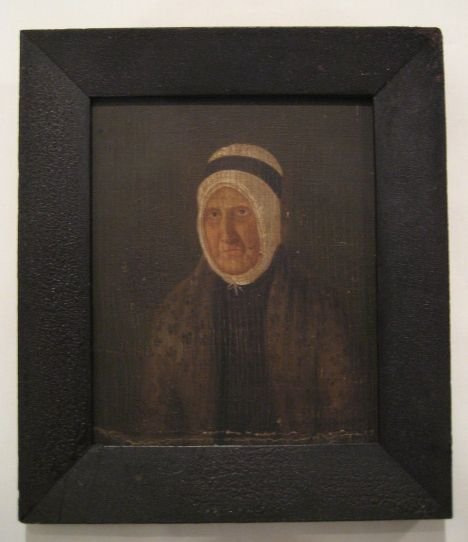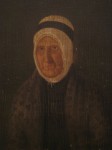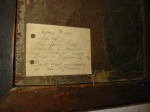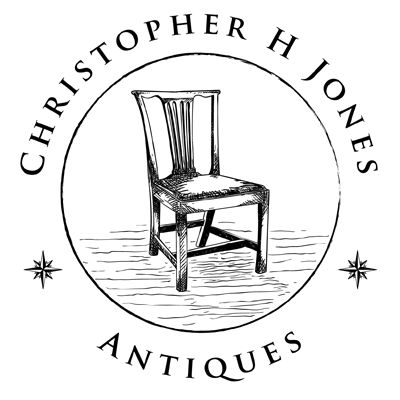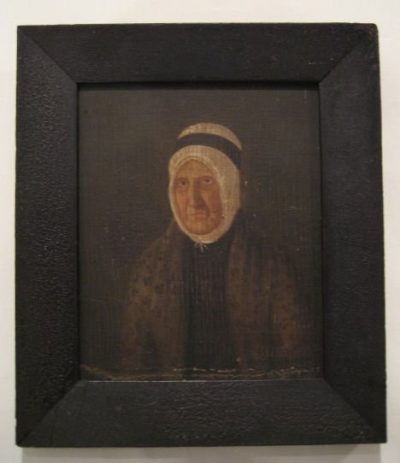 Oil on wood panel – 6 1/2” x 7 3/4”
Oil on wood panel – 6 1/2” x 7 3/4”
Early, probably original, painted wood frame
Unknown artist
Virginia, ca. 1780 – 1890
Commentary : During the last years of the 18th century the interior of Virginia was frequented only rarely by any of the few “professional” portrait painters working in America. Most portraits were the work of itinerant artists or a local sign or carriage painter earning extra income by painting likenesses of his family and neighbors. This portrait is characteristic of the unpretentious, straight forward work of such an artist, unencumbered by academic training but possessing some native skills. In many respects the portrait resembles the work of Jacob Frymire who worked in the regions but no firm attribution can yet be made. In scale and simplicity of the image, it stands in sharp contrast to the grand, continental European tradition of portraiture favored by the tidewater and urban gentries. Agnes Wyse’s portrait is a rare surviving example of the art that was accessible and affordable for the “middling” and lesser members of society in the first years of the Republic.
According to the inscription attached to the rear of the panel, Agnes Wyse was the wife of Ninnean Wyse and lived in Fauquier County, Virginia. She is additionally identified as the great, great grandmother of John H. Mackie. Also included in the inscription is the notation “emigrated to America from Scotland 1745” that seems to refer to Ninnean rather than Agnes.
Agnes and Ninnean Wyse first appear as a couple in Virginia legal records in the 1780s. Fauquier County records indicate that in 1782 one Samuel Blackwell was bound to Ninnean Wise “stone mason.” In 1787, Ninnean and Agnes Wyse were recorded as having purchased 57 acres “with all its houses, barns improvements & appurtenances” for 57 pounds from Wiley and Sarah Roy in the County’s Hamilton Parish near Turkey Run. This record notes that Agnes was from Prince William County, Virginia, although no record of their marriage has been located in the surviving county records. Ninnean and Agnes sold their Fauquier County property to Gustavus Brown Horner a few years later and moved to Richmond where he appears in legal records as taking the orphan George Crump as an apprentice in 1792. In 1807, Ninnean Wyse purchased four acres in Henrico County and later in the same year, he and Agnes sold a part of this property and a “brick tenement and other Improvements erected thereon by him the said Ninian Wise” to their daughter (?), Margaret. The couple had a least two additional daughters, Mary, whose wedding was recorded in Henrico County in 1797, and Nancy, whose wedding was recorded in Richmond in 1803. (Ninnean and Agness also apparently lived in the vicinity of Port Royal during the period 1790 – 1810 where he was noted in local records as a stone mason.)
Various surviving records indicate that Wyse was both a stone mason and a manufacturer of bricks, which he used on several occasions to pay off debts. The largest building project with which Wyse was known to have been involved was the construction ca. 1803 of the Richmond Armory that was located at the foot of Fifth Street on the south side of the James River. Apparently Wyse and James Carney, a partner, secured the contract to construct the foundations for the building that were later found to have been inadequate. Virginia State Papers record a lengthy and complex dispute that seems to have culminated in Wyse being absolved of responsibility.
Ninnean Wyse died in 1807. His death was reported in the Virginia Argus, December 8, 1807 with the brief notice: “Died – Mr. Ninnan Wyse, who drowned on the 5th of November. Body found in the basin of the canal on December 2nd. He was a native of Falkirk, Scotland, age 65.” Wyse headstone however, states that he was born in 1742 and died in 1807 at the age of 69 indicating either a mistake in the year of birth or mathematics. The remaining acre of land in Henrico County “near Colonel Adams’s (sic) sawmill” was sold “to let his widow have her part” and to repay his debts. He was buried at St. John’s Church in Henrico County where his age was given on the headstone as 69.
Agnes survived her husband but no record of her death has been discovered in Virginia or Maryland records.
A Ninnean Wyse was listed among the Scottish prisoners arriving at the port of Oxford, Maryland aboard the Johnson, William Pemberton, Master, on July 20, 1747. According to Thomas Scarf’s History of Maryland from the Earliest Period to the Present Day, these prisoners were among many partisans who had supported Prince Charles Edwards, “the young Pretender,” who were transported to England for trial after the uprising. Some were hanged and others, like Wyse and some one hundred compatriots, were deported to the colonies were they were frequently sold at auction as laborers. Although the age of this Ninnean Wyse was not recorded, he could have been a very young man when he arrived in Maryland or the father of Ninnean, husband of Agnes. Ninnean may have met Agnes in Accomack, on Virginia’s Eastern Shore, not far from Oxford, where an Agnes Wise appears in census records in 1810 and 1820. This suggests the possibility that she returned to her family’s home after her husband’s death, but, in the absence of her maiden name and early marriage records for Accomack County, it is not possible to firmly establish such a linkage.
Condition: The painting has been professionally conserved by Alexandra Tice of Chevy Chase, MD. The painted wood frame is very likely original and has a dark, aged surface.
Sold
Additional Photos:
Without Frame
Close Up
Rear

